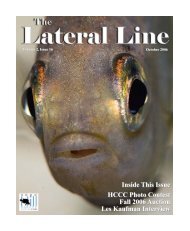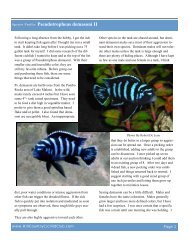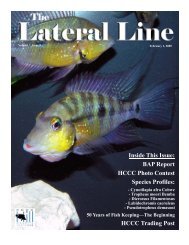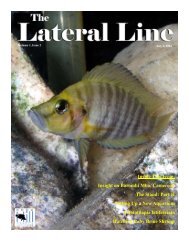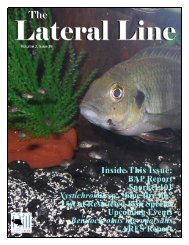Lateral Line March 2011 - Hill Country Cichlid Club
Lateral Line March 2011 - Hill Country Cichlid Club
Lateral Line March 2011 - Hill Country Cichlid Club
- No tags were found...
Create successful ePaper yourself
Turn your PDF publications into a flip-book with our unique Google optimized e-Paper software.
5#3 for this article. Lighting is the 3rd largestcost in my fish room and as such it raisestwo primary concerns. The first is the capitalinstallation cost and the second is themonthly electrical bill. The age old questionarises, “If you had $1000 and you couldspend it however you choose, what wouldyou buy?” It is a good thing that I don’t have$1000 to spend, as I would have one ofthose new fancy LED HD TVs sitting in myliving room if I did. The upfront “capital”cost of lighting falls into this category.Would your $1000 go into replacing yourfish room lighting? This upfront cost is theprimary reason that LED lighting has notgained a stronger foothold inside of theUnited States.The largest problem that exists with LEDlighting is the capital cost. Retailers andmanufactures are marketing the products atsuch high margins that it is cost prohibitivefor the average Joe cichlid keeper with about20 aquariums to upgrade his lights. The onlypeople that can even scratch the surface ofLED lighting are those that have only one ortwo aquariums. The rest of us are just left inthe dark (well, not literally in the dark, westill have our fluorescents…).In aquaria there are many systems of lighting.I am analyzing only three. Of the threesystems of lighting, two are my own DIYhome creations, and as such are designedwith my needs in mind. The third system is asystem commonly found in aquaria installations.Today we look at the three installations:1. The Shop Light2. The Compact Florescent3. The LED LightThe Shop Light is by far the most commonlighting system in use today. Although nowas wide spread, many people around theUnited States have started using a CFL(Compact Florescent Light) design installedin their fish rooms as well. The primary purposeof a CFL design is to “save space”above the tanks. This is a concern because,although strip lights are cheaper, they takeup 3” of space above an aquarium and get inthe way when performing maintenance. In arack situation the space saving design wascritical and my primary purpose in designingthe light installations #2 and #3.My Test Setup:In all of my experiments, I am using a threetiered rack design. My test design will housesix 20 Breeder aquariums. The 20 breeder isan uncommonly sized aquarium with nearideal dimensions. The dimensions on the 20breeder are approximately 24” long, 18”wide, and 12” deep. This is great for juvenilesand fry grow out, and can even housepairs of fish that are not overly aggressive. Istacked the tanks so that I will have 10” ofclearance between the top of an aquariumand the bottom of the next shelf. Twoaquariums are going to be installed on eachshelf, making the entire setup 80” from thefloor to the top of the top aquarium. Thisheight was chosen because I can feed thefish in the top aquarium without a stool, ladderor chair as it is just within reach.In the below sections, I outline the type ofinstallation, the impact the installation hason “space” above the aquarium (how muchit eats into the 10” of clearance I left in therack), the impact of upfront costs, and themonthly maintenance cost of the setup. Inconclusion, I will summarize the cost ofownership by year for the first 5 years andany thoughts and opinions that I have on thesubject.I wish to make it clear now, that my homemade designs are not “approved” for use



